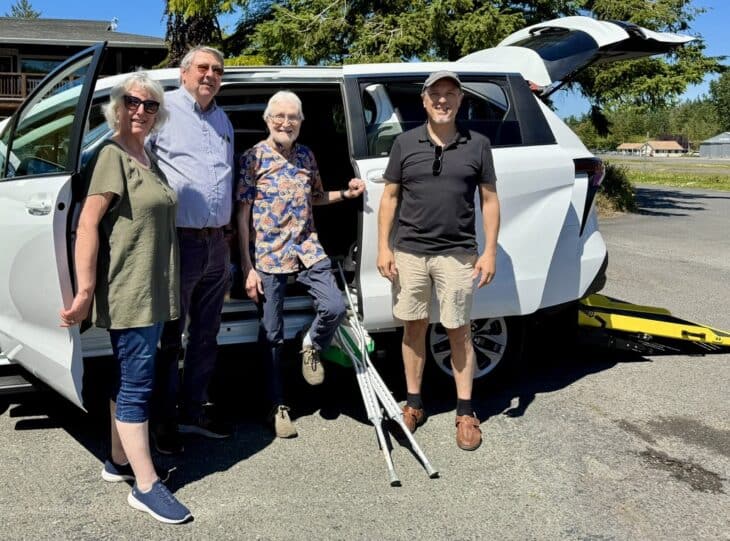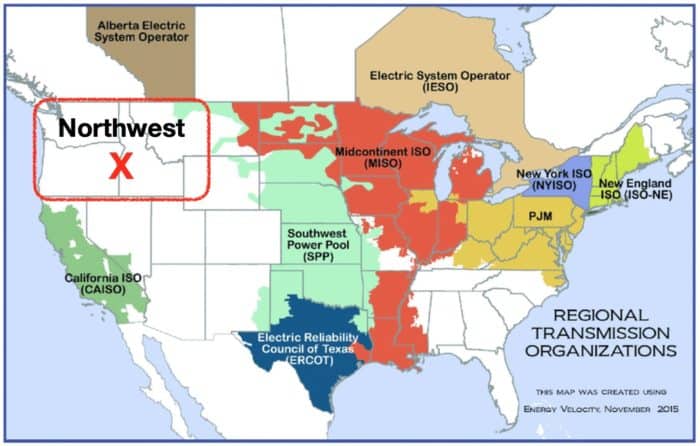Why Local Renewable Projects? Mainland Power Demand Will Soon Exceed Supply
OPALCO is Preparing for Mainland Rolling Blackouts
Did you know the Northwest power grid almost crashed during the January 2024 cold snap? As the hydro system hit capacity, the region turned to California, the Southwest, and BC to import massive amounts of energy. Wholesale electric prices jumped 2,400%.
Why are mainland rolling blackouts becoming more likely?
It’s a basic problem of electricity Supply and Demand:
- Supply is falling as coal power plants are shut down to slow climate change, but replacement renewable energy projects are held up or canceled due to public and local permitting pushback.
- Demand is increasing as the Northwest population grows and rapidly shifts from fossil-fueled to electric transportation and heating. In San Juan County, over 80% of greenhouse gas (GHG) pollution comes from transportation and to reverse the global climate catastrophe, the US must cut emissions by 50% by 2030.
The northwest region is at an energy tipping point. The chart at right illustrates how the supply-demand gap increases over the next ten years. An minimum of 30 GW of new renewable energy supply will be needed to meet the rapidly growing demand – almost double what is used today. Over the past 20 years, the Northwest has only been able to build about one GW per eight years. Rolling blackouts and market price shocks will increase until supply can meet demand.
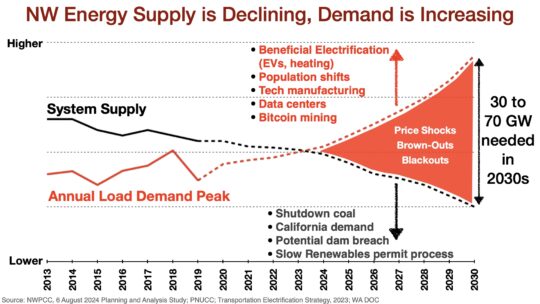
How is OPALCO preparing?
Over 96% of OPALCO energy currently comes from the mainland, and most of the significant OPALCO outages are due to mainland outages. During the January cold snap, mainland electricity price extremes flowed through to OPALCO and co-op members. To maintain reliability and reduce price shocks, OPALCO plans to develop more local energy capacity – a combination of solar and tidal energy.
Load and local rooftop solar generation are both growing, but by 2035, load will have significantly outrun rooftop solar capacity. Since OPALCO introduced its very successful Switch It Up! on-bill financing, rooftop solar installations have grown quickly. But OPALCO projects that the number of viable residential and commercial roofs and parking areas will only supply an additional 2.8% of local energy by 2035.
Referring to the chart below, 31% of load will need new power sources. There is no new hydro, so new supply will either be bought at increasingly expensive and stressed mainland prices, requiring a third submarine cable to the mainland, or generated locally.
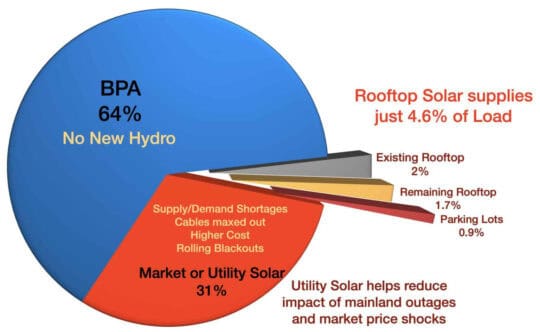
Rooftop solar can only supply a small fraction of our local energy (less than 5%), and it doesn’t work during outages. To reduce the impact of mainland outages and price spikes utility-scale solar arrays can supply what’s needed using just 0.5% of county land. The map at right shows four red squares on land, representing the amount of land needed for community solar arrays, and one red square east of Blakely Island, representing one tidal generator. The Pacific Northwest has a limited solar profile – where 4 months out of the year you are producing very little of your energy needs.
OPALCO built its first community microgrid project in 2018 on Decatur Island, where islanders have hailed its improving island power during outages.
The planned Bailer Hill Microgrid project is OPALCO’s next community solar array. It will more than double the county’s local energy compared to all the rooftop solar, which took 13 years to build.
It is our first agri-solar project, in cooperation with local farmers who will graze sheep in the shade of the solar array. $1M of the project is allocated towards OPALCO’s low-income energy assistance program through grant funding.
This and future microgrids can only happen if there is public support for it. On the mainland, over 70% of utility renewable energy projects are canceled due to local permitting and public opposition. In San Juan County, with 540 acres of land we could produce 30% of the annual load – as illustrated in the to scale chart below.
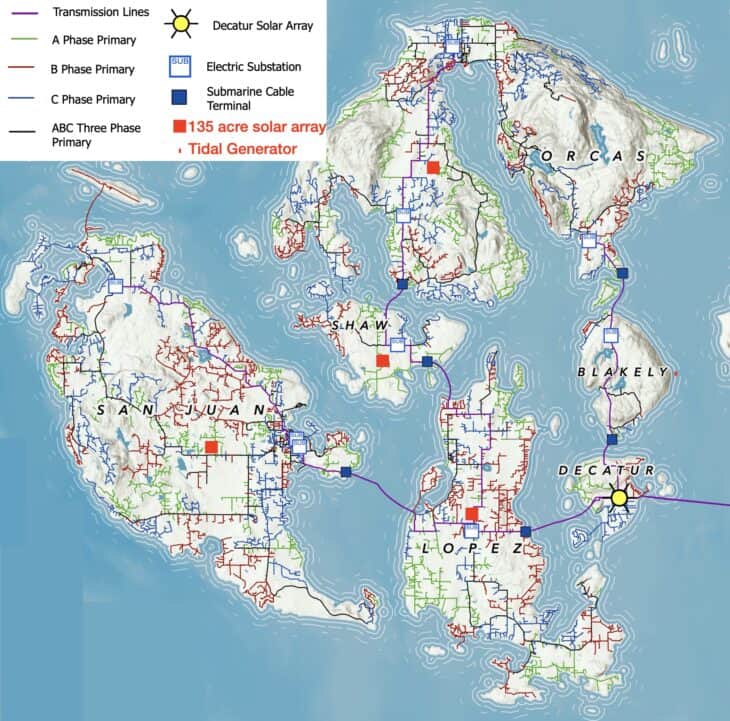
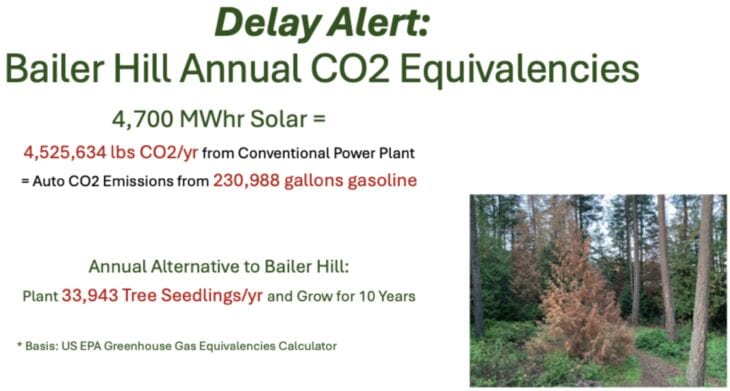
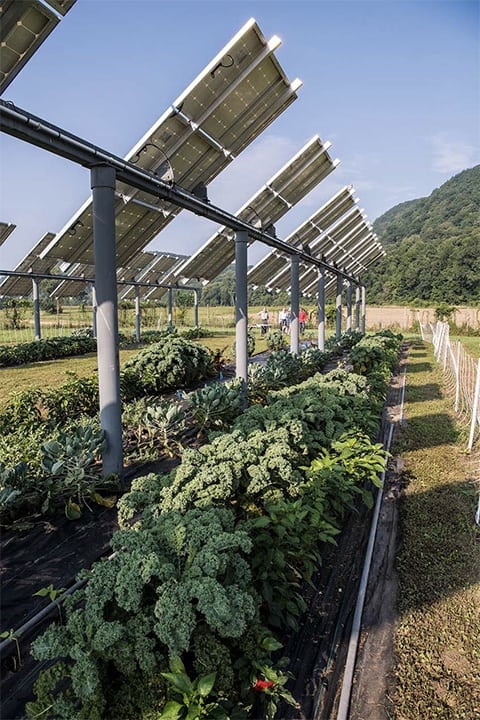
Learn More: links and references
Harvesting the Sun – This video is chock full of agri-solar info. Featuring experts from Oregon State University (OSU), the National Renewable Energy Labs (NREL), and others.
“In Harvesting the Sun, the leading voices of the agri-solar movement come together to share their stories and shine a light on a climate solution that can increase farm profitability, save valuable water, improve the soil, provide shade for farm workers, develop valuable ecosystem services, and increase the resiliency of rural communities.”
Energy System Near Miss – February 2024 OPALCO Board meeting presentation on the January 2024 cold snap. Includes analysis of 25 GW gap in supply and demand.
Cold Snap Strains Northwest Utilities as Energy Prices Surge – In the days before the cold front came in, SnoPUD held back water at its 112 MW Jackson Hydro Project. Once the temperatures started to fall, it ran the project at max generation throughout the event. The PUD still had to turn to the market despite the high prices. “It was all-hands on our power trading desk.” “Market prices hit the Western Electricity Coordinating Council’s $1,000/MW soft cap. The California Independent System Operator raised its soft cap from $1,000/MW to $2,000/MW for several hours during the three-day-long cold snap”
Counties are blocking wind and solar across the US – USA Today – Statewide blocks and limits put the nationwide goal to reach 100% clean energy by 2035 at risk.
“Local governments are banning green energy faster than they’re building it.”
A New Surge in Power Use Is Threatening U.S. Climate Goals – NY Times – “Many power companies were already struggling to keep the lights on, especially during extreme weather, and say the strain on grids will only increase. Peak demand in the summer is projected to grow by 38,000 megawatts nationwide in the next five years, according to an analysis by the consulting firm Grid Strategies, which is like adding another California to the grid.” “The stakes are high. If more power isn’t brought online relatively soon, large portions of the country could risk blackouts, according to a recent report by the North American Electric Reliability Corporation, which monitors the health of the nation’s electric grids.”
Quick Fact: Northwest Resource Adequacy in a Rapidly Decarbonizing World – OPALCO has been concerned about the growing supply-demand problem for several years. This Quick Fact from two years ago has more background and links to deepen your understanding of rolling blackouts, and forecasts on load and generation.
Congressional action on energy permitting remains stuck, but states and developers are finding solutions Environmental advocacy group Natural Resources Defense Council is breaking with its past position to agree. “NRDC has historically said ‘no’ to infrastructure that was a threat to the environment,” said NRDC Senior Clean Energy Transmission Advocate Cullen Howe. But pivoting to “yes” by pushing to make permitting reforms more efficient is “a necessary change,” though the reforms will likely force “hard choices,” he acknowledged.” “Outdated environmental rules and hundreds of amendments and judicial interpretations built into them are causing “a crippling delay in permitting new projects,…”
Solar on Farmland – Opportunities and Considerations in NW Washington – This excellent 88 minute video is moderated by Faith Van De Putte, San Juan County Agricultural Resources Committee, hosted by WSU SJC Extension and SJC ARC. It features farmer and OSU engineer Chad Higgins.
“In the face of climate change and development pressure, Northwest Washington needs both solar power generation and increased protection of agricultural land. Agrivoltaics are an emerging strategy that incorporates photovoltaic arrays into agricultural systems. We take a look at some pros and cons of adding solar to a farm operation, offer some considerations for where and when to site solar on a farm, and discuss what to include in your decision-making tree as you think about adding solar arrays to your farm or land. We also hear about the impact of solar on agricultural ecosystems, the opportunities it provides, and a brief overview of the costs of installation and incentives that are available. This presentation is geared toward farmers and agricultural landowners, although all are welcome.”
Agrivoltaics Combines Production of Agriculture and Solar Power – Sierra Club
“Agrivoltaics, which pairs solar panels (photovoltaics) with agriculture, is a double-duty climate solution that yields benefits to farmers while minimizing the Nation’s need to use undeveloped natural lands for solar energy development.”
Agri-solar generation is being deployed in farmland worldwide and is proving much more cost-effective and efficient than rooftop solar. In less than a year, the most recent planned Bailer Hill agri-solar project will more than double the local energy in the county, compared to all the rooftop solar in the county, which took 13 years to build. And at a small fraction of the price and time to build rooftop solar.
The 2022 USDA Ag Census of San Juan County farmland economics shows that we have 264 farms, on 19,571 acres, averaging 74 acres per farm. Even with government subsidies, each farm loses an average of $3,754 annually. And the cost of farmland is rising rapidly as our population swells. The economics are not sustainable. To increase local food production, we need healthy farm economics. Agri-solar is raised up on stilts, allowing farming beneath. It increases farmland productivity and provides dual use of the sun – producing food and energy. That energy produces an additional income for the farm of about $8,300 per acre per year, turning the typical farm here cashflow positive. 35% of county electricity use could be generated with just 0.5% of all land in San Juan County.


